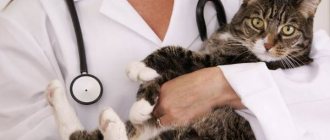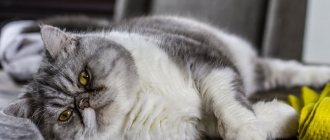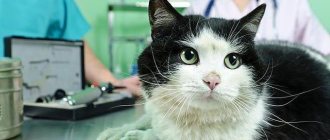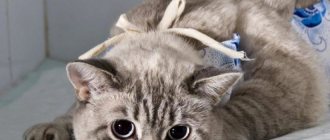Home » Useful Information
In order to save cats from sexual heat, which is accompanied by unpleasant symptoms for the animals themselves and associated problems for the owners, many owners turn to veterinary clinics to have their pet spayed or neutered. Sterilization performed on cats is fraught with many complications, the most common of which is the formation of swellings and bumps localized near the suture in the postoperative period.
- 2 Reasons for appearance
- 3 When to see a doctor
- 4 Preventing the appearance of a lump on the stomach
4.1 Video: post-operative cat care
Complications after cat sterilization
If the animal was properly prepared for surgery, and the operation itself was performed by an experienced doctor, complications are unlikely. However, in some cases they still occur. The person’s task is to properly care for the operated cat, monitor its condition and inspect the injured area daily.
After sterilization, complications may appear such as:
- swelling in the suture area;
- allergic reactions (rash, swelling of the mucous membranes);
- lethargy, drowsiness;
- lack of appetite;
- arrhythmia;
- heart failure;
- loose stools or constipation;
- urinary incontinence;
- internal bleeding;
- hard or soft lump on the stomach;
- enlargement of the mammary glands;
- hernia;
- peritonitis;
- wheezing breathing;
- pulmonary edema;
- anaphylactic shock;
- bleeding of sutures.
Sometimes more than one of the above symptoms may occur. Signs of the inflammatory process are increased body temperature and redness of the skin. If you do not contact a veterinarian in time, complications can lead to the death of the animal.
Post-surgery lumps are often confused with a mammary tumor in a cat. There is a difference between them. In most cases, the lump goes away on its own. The tumor only grows over time, and similar tumors form next to it.
Treatment and prevention
If, after sterilization, the cat has a lump under the stitch, it lasts for several days, pus has formed, the cat has become irritable or apathetic, you should immediately consult a doctor.
Let us note the various treatment options:
- After the operation, a hernia appeared. In this case, the veterinarian evaluates the animal’s condition and may prescribe a second operation or correct the hernia.
- Pus has formed. In a clinical setting, the pus is removed and medications are prescribed to stabilize it. In extreme cases, a repeat operation will be required. Veterinarians will often prescribe ointments or a special blanket to support the pet's abdomen. This way the stitches will not come apart and the pet will not be able to lick the sore spot. This procedure will protect against re-infection.
- Serious inflammation. In most cases, it is better for the animal to remain in the clinic for a while under the supervision of doctors. Sooner or later the pet will return home.
Let us note the basic recommendations that doctors prescribe:
- Special diet. Much depends on the breed and nature of the disease. Veterinarians often recommend special collars to limit the cat's food intake. You can use specialized dry food for animals that have undergone surgery. Portions should be small, food (if it is natural food) easily digestible. It is better to grind the food and keep hard pieces to a minimum.
- The diet when a seal appears on the seam and after its elimination is extremely important. Any problems with the gastrointestinal tract - constipation or excessive gases can greatly affect the dehiscence of the suture. If the cat starts vomiting, this is a sign of recovery from anesthesia. It is worth limiting your pet's food intake and providing plenty of fluids.
- Increased attention. Don't bother your cat unnecessarily. Protect her from drafts and contact with other animals. improve your sleeping area. For example, put new litter in a cat's nest. If necessary, provide favorite toys and clean drinking water. It is better to place the bowl next to the sleeping area.
- Required activity. The animal can sleep a lot, but periodically make it move. A supervised walk around the apartment would be an excellent choice. Avoid active games with your cat, and do not let her play with her favorite toys for a long time.
The main thing is not to delay treatment if a lump appears under the stitch.
IMPORTANT! It is important to know that this may not just be a hernia, but a serious cancer. Under no circumstances should you self-medicate.
If a seal appears on the seam, consultation with a veterinarian is required.
Why does a lump appear after sterilization?
Normally, after removal of the internal reproductive organs, a cat does not develop swelling or neoplasms. If this happens, you need to observe the animal. Most often, such bumps do not bother the pet and disappear 12 hours after the operation. If the tumor does not decrease and the cat’s condition worsens, you need to contact a veterinarian.
The following causes of postoperative bumps near the suture are identified:
- Healing process. Often during regeneration the skin thickens. A small tumor measuring 0.5-1 cm may appear. It does not cause discomfort to the pet. Within a month, the lump resolves on its own.
- Incorrect suturing. The doctor violates the technique of stitching the skin or uses low-quality materials for this. The consequence is infection entering the wound and the development of an inflammatory process.
- Allergy to medications. Antibiotics, anti-inflammatory and painkillers can cause allergies, which result in single or multiple lumps on the abdomen.
- Lack of quality postoperative care. The cat needs to wear a special collar and blanket. This will prevent her from licking the wound. It is necessary to regularly make dressings and treat the surgical incision site with antiseptic agents.
- Lymphadenopathy. After removal of the internal genital organs, the lymph nodes located in the groin may become inflamed. This is due to an increased load on the immune system and weakening of the animal’s body. If the nodes become inflamed to such an extent that they take the form of lumps on the abdomen, the cat must be taken to the veterinarian.
- Herniation. This occurs due to the divergence of the internal sutures and protrusion of the intestine. The lump is soft and painless on palpation.
- Oncological pathology. Due to hormonal imbalances, stress, and genetic predisposition, a tumor with malignant cells may appear. It may be present in the body even before surgery. However, cancer cell growth often accelerates after surgery.
- Renal polycystic disease. This violation sometimes coincides with sterilization. Swelling in the abdominal area occurs rarely and is accompanied by pain.
- ICD (urolithiasis). Stones can block the urethra. It is difficult to pass urine. The cat's belly is swollen. A hard lump forms in the area where the stone has blocked the urethra.
Only a veterinarian can diagnose the cause of the tumor. If the cat's condition does not return to normal within 12 hours from the onset of negative symptoms, you should consult a doctor.
What to do and how to help the animal?
Any deviation from the norm in an animal should be examined by a specialist.
If owners find that the seam after sterilization looks bad or a lump has formed on the stomach, then they should immediately contact a veterinarian. Veterinary care is especially necessary in case of prolapse of a hernia or in case of a purulent process and infection in a postoperative wound. If after a few days the swelling does not decrease and the cat experiences unpleasant symptoms, then urgent diagnostics and treatment are required to prevent complications. The specialist will examine the lump in the abdominal area and assess the general condition of the pet after sterilization.
In the case of a hernial protrusion without pinching, the veterinarian re-stitches or reduces the formation. When the pathology is advanced and the abdomen is very swollen, surgical intervention is required. Often the lump is the result of a malignant or benign tumor, then the cat is first prescribed laboratory and instrumental tests, after which treatment is selected. For cancer, chemotherapy and surgery are indicated, and if the situation is advanced, then measures are taken to carry out maintenance therapy.
It is possible to cope with a lump on a cat’s stomach caused by urolithiasis with the help of medications. A sick cat is prescribed special stone-dissolving drugs, and if the stones are large, they are removed surgically.
Lump on the seam
Soft or hard neoplasms can form on the surface of postoperative sutures. It is necessary to evaluate the texture of their surface, and also observe whether they cause pain to the cat. The size of the tumor also matters. The bigger it is, the worse it is.
If the lump appears 3-4 days after the operation and is initially hard to the touch, but softens after a few days, this indicates bacterial insemination of the suture. The skin in the affected area is red, inflamed and hot. Characteristic is the leakage of purulent exudate. Pathology threatens sepsis and death. The pet needs to be shown to a doctor as soon as possible.
If the growth on the suture is small, hard to the touch, does not grow and does not cause pain to the cat, it may be the remains of surgical threads. This neoplasm is not dangerous, but can only be eliminated surgically. Therefore, a visit to the veterinarian is mandatory.
If the appearance of a lump is accompanied by itching, this indicates an allergic reaction. At home, you can give your cat ¼ tablet of Diphenhydramine. However, consulting a doctor will not be superfluous.
Causes of hernia
There are two main causes of hernias: congenital and acquired. If a congenital disease appears as a result of intrauterine development in the form of an overly large anatomical hole in an organ or canal, then such a “gift” can be purchased in different ways.
Perineal hernias can occur due to weakness of the gluteal muscles or due to low amounts of the hormone testosterone. Intervertebral discs appear more often in older animals, and diaphragmatic pathology mainly manifests itself as a result of injury.
global $ads_google; //data-ad-slot=”2475549904″ $ads_google = empty($ads_google) ? false : true; ?> if ($ads_google == false) {?>
$ads_google = true; ?> } ?>
Other types of hernias may pop out due to constipation or flatulence. Such problems are more often detected in older cats than in young, active cats.
Lump under the seam
Neoplasms that have arisen under the sutures are dangerous. Consultation with a veterinarian is required, because... there is a high risk of death of the animal. After the operation, coordination of movements is impaired, and the cat may hit itself somewhere.
The consequence is hematomas and bruises. Their signs may include pain, thickening, and discoloration of the skin. Local body temperature rarely rises.
If the cause of the internal tumor is an abscess, it threatens peritonitis. It is necessary to inspect the seams very carefully so that the tumor does not burst.
An abscess is characterized by symptoms in cats such as:
- weakness and drowsiness;
- poor appetite;
- increase in local and general body temperature;
- pain in the affected area.
If immediately or a few days after sterilization your pet is found to have a pathological tumor in the operated area, you should consult a doctor. It is better to call a veterinarian to your home so as not to create even more stress for the animal. If surgical treatment is necessary, the doctor will take the cat to the clinic.
Types of sterilizations and potential consequences
What is sterilization? This is a surgical intervention in the body of an animal in order to suppress or deprive it of sexual reproduction.
The operation is performed under anesthesia. As a rule, after 1-2 weeks of competent rehabilitation with increased attention to the pet’s nutrition and rest. Potential complications largely depend on the type of sterilization:
- The classic method is an incision along the white line of the cat's belly . It is considered the most dangerous of those presented. But the likelihood of harming an animal decreases every year due to the improvement of the sterilization process.
- Lateral section - an incision is made in the same way, but the muscle tissue is then gradually moved apart. This shortens the recovery period after surgery.
- Laparoscopy - the operation is performed using specialized equipment. Characterized by speed and high cost.
Lateral section and laparoscopy are the safest methods. Most complications arise during classical sterilization.
ATTENTION! The appearance of a lump after sterilization in a cat is not the only problem caused by poor-quality sterilization.
For example, unraveling of suture threads, infection with microorganisms after sterilization, or hormonal imbalances. As for the main question, a lump may appear at the site of the incision, on the seam or under it.
Herniation
A few days after surgery, your cat may develop a lump on its side. Most often, this symptom indicates a postoperative hernia. The cause of the pathological condition is the divergence of internal seams. This happens due to too rapid resorption of the threads, the use of low-quality surgical material, or illiterate actions of the doctor. The external seams are not damaged. When pressed, the tumor quickly disappears. It feels soft and voluminous to the touch.
A hernia in a cat after sterilization is formed from the omentum or intestinal loop. It is dangerous because it can become strangulated, leading to intestinal necrosis and fecal peritonitis.
The animal must be shown to a doctor. The veterinarian will examine the cat, conduct the necessary tests and make recommendations. Treatment of a postoperative hernia is only possible through surgery. To avoid dangerous consequences, it is better to carry out the operation as soon as possible.
Treatment of postoperative hernias: general information
Breeders should remember that the treatment of such pathologies is exclusively surgical (as a rule), in a well-equipped veterinary clinic. If the pathology is not advanced, therapy is quite simple:
- First (using the same palpation and ultrasound), the veterinarian accurately determines the boundaries of the hernial ring and the diameter of the canal. This is necessary to determine the surgical technique, suture material and other important factors.
- After this, the specialist decides on the anesthesia technique. In some cases, when a hernia has just appeared, only local anesthesia is sufficient, but in situations where the neoplasm has already reached a large size and upon palpation the intestinal loops and other internal organs are clearly felt in it, general anesthesia is necessary.
- After administration of anesthesia and general preparation for the operation (including fixation of the animal, shaving of the surgical area and its antiseptic treatment), an incision is made.
- Through the surgical incision, the veterinarian will set the internal organs back into the abdominal cavity, after which the hernial sac will be sutured.
- If the skin at the site of the former sac is greatly stretched (which often happens), it is trimmed, the cavity is lightly powdered with veterinary powder based on streptocide, after which everything is sutured.
Treatment
Sometimes a small bump under or above the stitch indicates tissue growth due to healing. An experienced veterinarian will always recognize this phenomenon and say that there is no need to worry. This swelling does not require treatment and goes away on its own after 3-4 weeks.
Infection and abscesses are treated with antibiotics. In severe cases, it may be necessary to open the abscess.
For bruises and hematomas, the doctor may prescribe the application of cold and treatment of the affected area with special gels and ointments.
For inflammation of the lymph nodes, the veterinarian prescribes antiviral and anti-inflammatory drugs. If the animal's body temperature is not elevated, dry heat is recommended.
What to do after surgery: rehabilitation and care
So what should the owner do? When the animal recovers from anesthesia (and this takes up to five or more hours), it should be given a little drink from a syringe (no more than 10 ml of water). The cat must be placed in a room protected from drafts, isolated from access to other pets.
Of course, the postoperative wound (like the animal itself) needs care. The owner of the animal does not have to do anything particularly difficult:
- You definitely need to get hold of a surgical blanket! This simple device prevents licking and scratching of the surgical suture (which inevitably leads to the development of complications, including purulent inflammation). The blanket needs to be changed as it gets dirty, but at least once a day.
- During the first week, you need to treat the seam once a day. For this purpose, miramistin, levomekol, chlorhexidine are used.
- It is necessary to ensure that the operated pet does not pretend to be a squirrel, constantly playing and jumping. It will take at least a week for her body to endure physical activity without consequences. Otherwise, the suture can easily come apart (which can lead to a new hernia or something worse).
- For the first four days, the cat should be fed with rich chicken broth, from time to time flavoring it with meat and vegetable puree (from baby food). This is necessary so as not to overload the digestive system of the pet, weakened after two operations.
Inguinal hernia in a cat
Description
If a cat often suffers from constipation or flatulence, then there is a chance that she will develop such a formation. In males, this phenomenon may be congenital. The protrusion in the form of a lump is located mainly on the stomach and does not pose any danger as such - there is internal fat inside the pouch. However, if internal organs protrude through the inguinal canal, then there is a chance of their being pinched. For a cat, this threatens infertility if the uterus is strangulated.
Symptoms
There is only one symptom - protrusion of a soft sac in the groin area. The more you delay, the more education there will be.
Treatment
So that the cat can continue its usual lifestyle, the hernial formation is removed through surgery. Due to the danger of rupture of the pudendal artery or damage to the nerve trunks, specialists carefully suture the wound and insist on high-quality postoperative care.
Symptoms and treatment
In addition to external signs of protrusion, the condition is accompanied by general signs of malaise, depending on which organs were compressed:
- nausea, vomiting, lack of appetite;
- diarrhea, followed by constipation and complete absence of stool;
- pain in the abdomen/groin/scrotum;
- back pain accompanied by impaired motor activity up to paw failure;
- pulmonary and/or heart failure.
The general treatment regimen usually follows two directions:
- surgical intervention;
- non-invasive treatment (without scalpel intervention).
If the protrusion is not pinched and can be reduced, then the animal is put on a special surgical anti-hernia blanket with a multi-tiered lining, which is worn for several months. During this time, the internal organs from the protrusion have time to fall into place, and the hernial “window” closes on its own. This bandage is not applied to all types due to the peculiarities of the anatomical structure of the body of cats and their natural mobility and plasticity. The blanket copes well with umbilical hernias and very rarely with inguinal and perineal hernias.
Umbilical
- Symptoms
In the area of the same name, a certain protrusion is detected. Usually soft and painless. When pinched, pain, local redness, swelling are observed, not only the local temperature rises, but sometimes the general temperature as well. In addition to local symptoms, nausea, vomiting, and signs of indigestion (diarrhea, constipation, or no bowel movement at all) may be observed. The diagnosis must be made by a specialist, because there is a high probability of confusing a hernia with an abscess.
- Treatment
In the initial stages, wearing a blanket (up to six months) is possible without infringement. If conservative treatment does not produce results, they resort to herniotomy - removal. If the hernia is reducible, then all its contents are reduced, and the edges of the umbilical ring are sutured. If it is irreducible and there is strangulation, then the operation is performed immediately, the bulging area is usually removed (usually against the background of necrosis, the area of the strangulated intestine and/or omentum can no longer be saved), the hernial ring is sutured.
Inguinal and scrotal
- Symptoms
Pathologies of the same type, with the only difference that a soft and painless protrusion is found in the same areas - in the groin or scrotum. A scrotal hernia is usually irreducible, because this is difficult to do due to the presence of the testis in the scrotum; the inguinal can be reducible, but this is pointless, because It is almost impossible to put on a blanket; organs will continue to fall out. They are often discriminated against. Symptoms: in addition to visual protrusion, the cat may limp, the limb protrudes to the side due to the inconvenience of walking, and when the bladder is pinched, there may be involuntary urination. When pinched, body temperature may increase.
- Treatment
Special bandages for inguinal, scrotal and perineal conditions are not used in practice. It is much more effective and safer for the health of the animal to perform the operation immediately. The subtleties of surgical intervention are similar to those of the umbilical. If it can be adjusted, everything is adjusted, the inguinal opening is sutured.
If it is impossible to reduce, after the incision the feasibility of preserving the strangulated area of the prolapsed organ is determined, the hernial sac is eliminated, the remains are reduced, and the hole is sutured. Particular attention should be paid to the operation if there was prolapse of the bladder and uterus during pregnancy. In the second case, the organ may have to be removed along with the offspring, taking into account the strength and duration of the infringement. If necrosis of the bladder occurs, then the animal is offered to be euthanized, because the process of urination becomes impossible.
Removal surgery only makes sense when it reaches a decent size and begins to cause discomfort to the cat. In all other cases, a wait-and-see approach is chosen, the pet’s mobility is limited and all attention is focused on the general condition of the animal.
Diaphragmatic
- Symptoms
It is impossible to notice such a pathology externally. It is also not always possible to look at X-rays and ultrasound. The main signs: shortness of breath, impaired heart function, the cat rarely lies down and more often on its side, it is clear that the animal is in pain due to the pain that the hole in the diaphragm causes when it contracts on the compressed organs.
- Treatment
Treatment is only surgical, and the earlier the diagnosis is made, the higher the likelihood of saving the pet. Prolapsed intestinal loops not only affect the heart and lungs, but they themselves are most often pinched due to the increased elasticity of the diaphragmatic openings.
The organs are set back in place, they are completely inspected, and at the same time, supportive therapy for the heart and lungs is required. The “hole” in the diaphragm is sutured. In rare cases, plastic surgery may be required to transplant fragments onto the diaphragm due to the hole being too large.
Perineal
- Symptoms
A soft and painless protrusion is found near the anus (in cats) or around the internal genital organs, slightly under the vagina (in cats). It can only be on one side, in rare cases it can be bilateral. There are no infringements. If you hold the animal by the front paws, the protrusion will become larger, and if you lift it by the hind paws, it will hide. This is a kind of test to clarify the diagnosis. Usually there are no additional symptoms and no signs of discomfort. But if the size is too large, it can put pressure on the bladder and internal genital organs.
Treatment is the same as for inguinal.
Pericardial-peritoneal
- Symptoms
It manifests itself with all the signs of pulmonary and/or heart failure, which increase at such a speed that most often they do not have time to help the pet. Shortness of breath and irregular heart rhythm are accompanied by complete apathy and refusal to eat and drink. Possible development of pulmonary edema (severe wheezing, coughing, sneezing with mucus). Murka should be taken to a specialist immediately.
- Treatment
The condition is practically incurable, because... the diagnosis is usually already made at the stage when it is no longer possible to compensate for pulmonary and heart failure. Moreover, most often animals die before a diagnosis is made (i.e., pathology is determined only at autopsy). The likelihood that a pet with this diagnosis will survive is very low.
Intervertebral
- Symptoms
Here, all symptoms are based on damage to motor activity, because The lumbar spine is usually affected. Coordination of movements is impaired, there is no stable support on the limbs (usually the hind limbs), the cat cannot jump somewhere, paralysis and muscle atrophy may develop. With deep degenerative processes, signs of damage to the central nervous system may be observed - convulsions, uncontrollable twitching of the limbs, etc. If there are signs of damage to the central nervous system, treatment becomes inappropriate.
- Treatment
No one will perform the operation right away. If motor activity is slightly impaired, then NSAIDs (non-steroidal anti-inflammatory drugs), steroids and painkillers are prescribed. If there is no result and there is at least some chance of help through surgery, an operation is performed. If motor activity is severely affected, drug therapy has not produced results, and surgery is not possible, then it is proposed to euthanize the animal, because it will no longer be able to live a full life.
Symptoms of hernias in cats
Let's consider hernia symptoms for perineal, scrotal, pericardial-peritoneal and intervertebral hernia.
- intervertebral pathology appears as a result of the disc being pressed into the spinal cord and provokes acute pain. Because of these painful sensations, cats do not want to move, their coordination of movements suffers, and a shaky gait or paralysis is possible. If the violation is serious, respiratory arrest and death are possible. First, there is a noticeable decrease in the animal’s activity, movements become constrained, and the cat begins to limp. Characteristic is causeless meowing and aggression that appears when trying to stroke the cat's back. Sometimes cramps are noticeable. If the sacral or lumbar region is affected, defecation and urination become difficult;
- perineal pathology practically does not cause problems for the pet: if the owner lifts the cat by the front legs, he will notice a protrusion that has formed in the groin area, and if he lifts it by the hind legs, the protrusion is pulled back and becomes invisible;
- scrotal can develop as a variant of inguinal, or be an independent disease. Like an inguinal hernia, cats develop a sac of visceral fat in the groin area. At first, apart from such a bulge, no other symptoms bother the animal, but if the disease progresses, then compression of the internal organs occurs. The disease can only be removed surgically;
- pericardial-peritoneal is characterized by cyanosis of the mucous membranes, apathy, lethargy, and difficulty breathing. Symptoms develop very quickly.
In each case, examination and consultation with a veterinarian is required.











